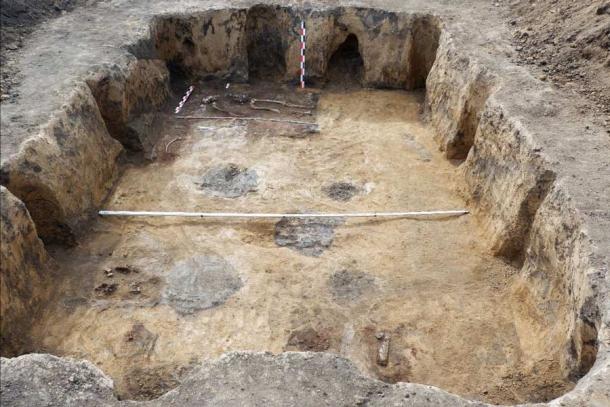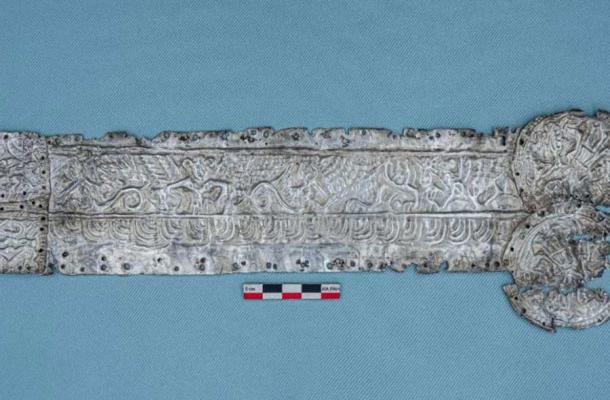A spectacular silver plate, richly adorned with winged gods and griffins, has been discovered inside the grave of a Scythian warrior who is believed to have died 2,400 years ago in Russia. And that is just one amongst the vast array of treasures found inside this tomb in a Scythian necropolis located high among the Caucasus mountains in Ostrogozhsky district of Russia.
The grave was excavated by the Don Expedition from the Institute of Archaeology at the Russian Academy of Sciences (IA RAS) by researchers who have been excavating the Devitsa V necropolis that consists of 19 burial mounds, reports Heritage Daily .
It was in mound 7 in the centre of the cemetery that a wooden tomb constructed with 17 large oak pillars, covered with half oak beams was found. Dating to the fouth century BC, the tomb housed the remain of a male warrior in his 40s who was buried with gold jewelry, small gold semi-sphere plates, an iron knife, a horse rib, a spearhead, three javelins, helmets, a horse rib, a harness, a molded cup, six bronze plates in the shape of wolves and several black-glazed vessels. The horse rib was probably remains of a ritual food offering.
Although the necropolis has been stripped of most of its treasures by ancient grave looters, the warrior’s grave seems have escaped their depredations on account of part of its roof having caved in, protecting some of its treasure from the plunderers.

The unearthed Scythian burial. Image Credit: RAS Institute of Archaeology
Winged Gods and Fantastical Creatures
It is the rectangular 14-inch- (35 centimeters) long and 3-inch- (7.6 centimeters) wide silver plate, which was found in the northeast part of the grave, away from the body and other items, that has fascinated archaeologists most. Profusely carved with figures ranging from Scythian gods to griffins and other fantastical creatures, it has an unknown winged figure facing the figure facing the Scythian deity Artimpasa, an androgynous goddess of warfare, fertility and sovereignty, Mail Online informs us.
Artimpasa’s torso is bare and she is wearing a headdress that seems like a crown with thorns. She is surrounded on both sides by griffins, who are mythical creatures with the head and wings of an eagle and the body of a lion. They are often seen along with Artimpasa in Scythian art and represent, according to experts, a fusion of cultural traditions between Asia minor and ancient Greece.
The left side of the plate is decorated with depictions of more fantastical creatures standing in a so-called heraldic pose, whilst the right side is decorated with two round buckles depicting an anthropomorphic character sporting a crown and flanked by two griffins.
Prof. Valeriy Gulyaev from the Don expedition said in a release from the IA RAS : “The discovery has made an important contribution to our concepts of Scythian beliefs. Firstly, a particular number of deities are depicted at once on one item. Secondly, it is the first example of an object depicting deities found so far from the main Scythian centres”. However, who the deities are and which item the plate, which was found nailed to a wooden base with small silver nails, decorated remain unclear.

Detail of the silver Scythian plate depicting fantastical creatures. Image Credit: RAS Institute of Archaeology
The War-like Scythians
The Scythians were an ancient horse-riding nomadic people living primarily what is now southern Siberia–in the region comprising the Eurasian steppes of Kazakhstan, the Russian steppes of the Siberian, Ural, Volga and Southern regions, and eastern Ukraine—between 900 and 200 BC. The Scythian civilization, which was a warring one, vaunts several intriguing features, not the least of which is the fact that women also took active part in combat.
Their fierce women warriors are believed to have been the inspiration behind the Amazons of Greek mythology. The Scythians were known for their deadly accuracy with arrows while on horseback. Ancient Greek writers, including the historian Herodotus, have claimed that the Scythians dealt barbarically with slain enemies, drinking their blood to proclaim victory and making drinking cups and cloaks from their skulls. They are also said to have conducted human sacrifices. According to the healer Hippocrates, women remained virgins until they had killed three of their enemies but once they married, they stopped taking part in battle.
Since they were nomadic, the Scythians built no cities and left no written records. The richly furnished graves of their leaders are the main source of information regarding their civilization. The contents of the graves, known as kurgans, are very well-preserved owing to Siberia’s freezing climate. This applies not just to the grave goods but also to the bodies themselves which, in some cases, still have the tattooed skins intact!
The dead had a profusion of gold jewelry, ornate vessels, weapons and other articles to accompany them in the hereafter. It is doubtful that this profusion of material comforts was of much use to them in their afterlife but it certainly helps us reconstruct aspects of their fascinating culture which would otherwise have been lost to the world.
Top image: Main: Scythians. Credit: Simeon Netchev (CC by NC SA). Inset: The silver Scythian plate Credit: RAS Institute of Archaeology
By Sahir Pandey
 RSS Feed
RSS Feed













 November 21st, 2021
November 21st, 2021  Awake Goy
Awake Goy  Posted in
Posted in  Tags:
Tags: 
















